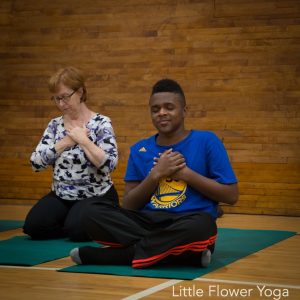Anchor breath is one of my favorite practices to teach my students. Anchor breath is the practice of using your breath to help focus your mind on one point. The instructions are to place your hand where you most feel the breath in your body. I offer three options: on your belly, on your chest, or in front of your nose. Some of my students choose to place their hands on their rib cage. That works too!
The placement of your hand and the sensation of breath is your anchor spot. The anchor spot is where you put your attention. As you breathe in, keep your attention on your anchor spot; as you breathe out, keep your attention on your anchor spot and repeat for a length of time. I usually start with 1-3 minutes depending on the group I am teaching. Once you notice you are not focused on your breath (maybe distracted by sounds, movements, thoughts) and that your attention has shifted, gently bring your attention back to your anchor spot.
The practice is to gently bring your mind back. For example, noticing “oh my mind has wandered” and then bringing the mind back to the anchor spot. Rather than get frustrated with your mind and thinking “ugh my mind is so stupid! What is wrong with me? I can’t focus!,” you notice you’ve lost focus and bring your attention back to your breath, to your anchor. Though the instructions are simple, the practice can be quite challenging since the mind is a thought-making machine.
When I offer this practice to my students, I want it to be relevant and engaging for them. Fortunately, there are many ways to share anchor breath with your students. I start by asking myself what is my intention to share this practice with this group of students? I have to be clear about why I want to teach the practice in order for it to be more interesting for my students and myself.
Here are three ways to explore anchor breath with your students:
1. Mental Training
I often first introduce anchor breath as a way to train the mind. I ask students if they have ever been told to pay attention. The most common response is yes. I then ask if they have ever been taught how to pay attention. The most common response is no.
I share the story of when I was in school and was also told to pay attention, but never taught how. What I learned was to look in the direction of the teacher and occasionally nod my head, maybe make a face of interest, and that was paying attention. Even if my thoughts were about the upcoming weekend, my friends, or what happened earlier in the day, I could look like I was paying attention. Many students are amused by my honesty and they relate to the story.
I explain that our minds are thought making machines. We cannot stop the process of thinking. We can notice when we choose to pay attention to something, however, and when we are not paying attention, we can bring our minds back to what we want to pay attention to.
It’s important that I set this activity up so that my students understand this is mental training for whatever is interesting to them, not just a way to be better at school. The most common interests for my students are sports, music, video games, and friends. Mental training can help us become more focused at playing sports, learning music, playing video games and even being a better friend. Many of us have had the experience of a friend talking to us and they say something that makes us go into our own thoughts. Midway through the conversation we realize we weren’t listening to our friend and now our friend is upset with us. When we can learn to direct our attention to our friends, notice when we aren’t listening, and bring our attention back to them, it helps to be a more attentive friend.
It’s important to explain that anchor breath is a practice. We are building the attention muscle in our mind. Just like a person that lifts weights has to continue to pick up and put down the weight to get stronger, we have to notice when our mind wanders to bring it back to build our attention muscle. Once my students have an understanding of what it means to focus, we then practice anchor breath.
2. Negative Self Talk
Once my students understand the idea of using anchor breath for mental training, I offer a new way to approach the practice. I want to encourage my students to be curious about their thoughts and build awareness around negative self-talk. We begin with a group discussion about thoughts. Is every thought we think true? After some debate among the students I ask them what thoughts they have that are true. The most common responses are most often pragmatic: 1+1=2 so that thought is true, and gravity exists so that is true too.
The follow-up question is: what thoughts might you have that may not be true? There is often a pause and then a student will say, “I’m stupid”, “I’m a failure”, “I can’t do this”, and “I’m ugly.” I honor their bravery sharing these negative and vulnerable thoughts and ask the group to raise their hands if they too have ever had those thoughts. Most students raise their hand and share they have experienced these thoughts.
I share my story of my thoughts and beliefs around feeling not good enough for years. I had this ‘not good enough’ belief around school, sports, family life and friendships. I felt like everything I did wasn’t good enough. One day when I told a friend I wasn’t good enough to do something, my friend asked who had told me that I wasn’t good enough. It stopped me in my tracks. The thought felt so true, I never paused to question it. Why did I have this belief about myself? Where did I learn this belief? And most importantly, do I want to continue this belief? This awareness of my negative thought pattern allowed me to actively work on replacing it with a more serving thought.
When we are curious about our thoughts, we are able to question what thoughts serve or don’t serve our well-being. We are empowered to choose what we want to believe about ourselves, others, and the world around us.
Rather than accepting the unconscious thoughts we learned, we begin to explore what we choose to believe about ourselves. We gain insight into who we are and want to be. Our thoughts can support us or hold us back on the journey.
In this version of the activity, we add a layer of curiosity. When the mind wanders we pause and watch with kindness and curiosity what thoughts appear before we bring our attention back to our anchor spot.
3. What is my mind working on?
We can use this practice as a way to learn more about ourselves. I share Kobe Bryant’s story about when he decided he was ready to retire from basketball. Kobe Bryant played for the LA Lakers for twenty years. In an interview he spoke about how for most of his career whenever he would practice mindfulness, he would notice his thoughts always went to basketball.
“I try to have at least 15 minutes of still time and just kind of sit in my thoughts in the morning and just kind of meditate. And normally what happens with me is my mind would always drift to the game. Always,” he said. “And then I found myself sitting there. My mind wouldn't drift towards the game all the time anymore. And that's when I started realizing, ‘You know what? It's getting close. It's getting close.’ Because now I'm not obsessively thinking about the game anymore. It's not wired into my subconscious the way it used to be.”
Later in Kobe’s career, during his mindfulness practice, his thoughts would go to other interests and not dwell as much on basketball. When he focused on where his thoughts wandered to, he realized he had new interests and passions he wanted to pursue. This realization helped him decide he was ready to retire from basketball.
When we practice anchor breath, we have the same opportunity to learn more about ourselves. We can notice when our mind wanders and where it wanders to. We get clarity on what our minds are working on. What are we feeling excited, passionate, stressed, upset about, or interested in? Instead of our thoughts being background music to our day, we get the opportunity to spotlight them and learn more about how we are doing and what is important to us.
Anchor Breath is a simple but powerful activity. It can support the ability to focus and reduce rumination. It can also support your students in having a greater understanding of their thoughts and how it connects to the way they experience the world.
If you think your students would like to know more about the way mindfulness supports athletes, you might want to check out the Golden State Warriors’ core values, which include mindfulness. If you are interested to learn more about the process of inquiry in regards to negative self-talk you can check out Byron Katie’s book, Loving What Is. Her work includes a four step process that teaches you to identify and question the thoughts and beliefs that cause suffering.
Also, click here for a recording of a five minute mindful breathing practice from mindful.org.
I hope these resources support you as you explore and introduce Anchor Breath and other mindfulness of breath activities to your students.
ABOUT ABIGAIL WILBER
Abigail Wilber (E-RYT, RCYT) is a teacher trainer and senior teacher for Little Flower Yoga. She is a certified Empowerment workshop trainer, has additional training in breath, anatomy and movement with Leslie Kaminoff and Amy Matthews, and has studied with Mindful Schools. Abby has many years of experience in working with typically developing children, as well as children who have special needs in grades K-12. Her passion is to empower children and to support parents in empowering their children. She is featured in GoNoodle’s Empower Tools videos.
We are a participant in the Amazon Services LLC Associates Program, an affiliate advertising program designed to provide a means for us to earn fees by linking to Amazon.com and affiliated sites. If you are interested in purchasing any of the resources mentioned above, you can help support free programs like Mindful Mondays by navigating to them through the included links. Thank you for your support!




















Thank you for this valuable contribution. I work as a learning coach and systemic counsellor in the school context and accompany more and more children and young people with attention difficulties. Much of what you recommend I have already practised in other forms in other contexts, e.g. self-care.